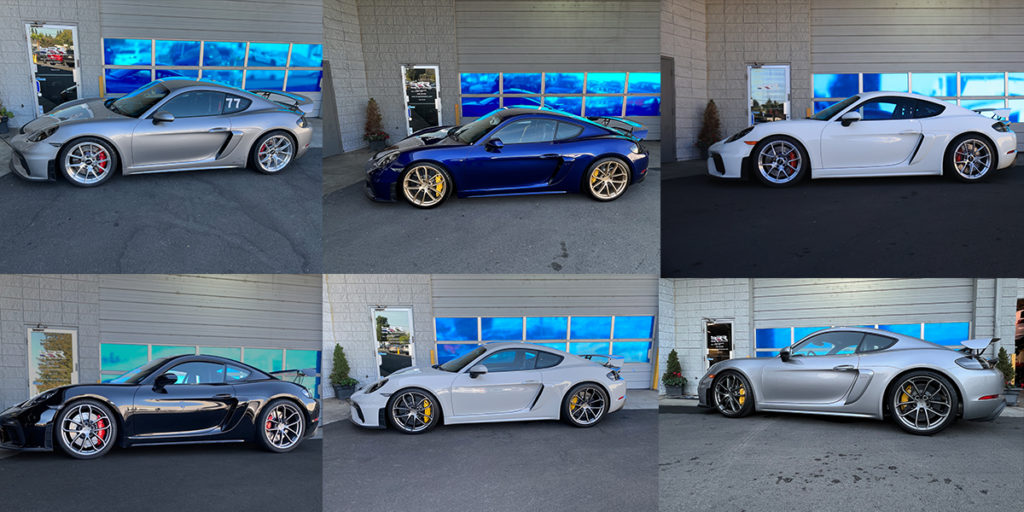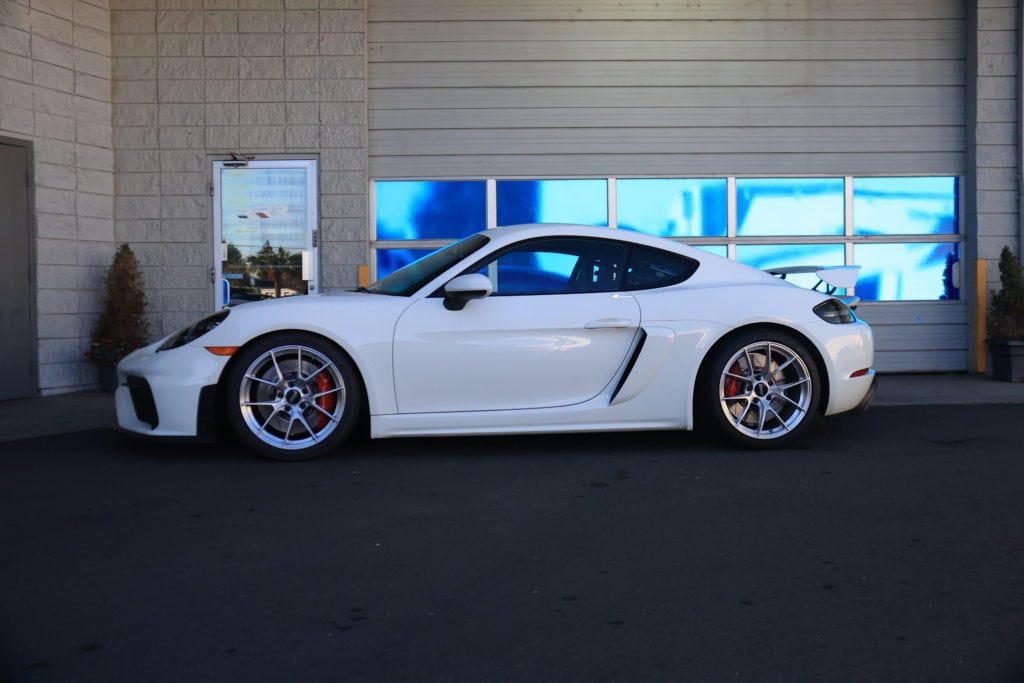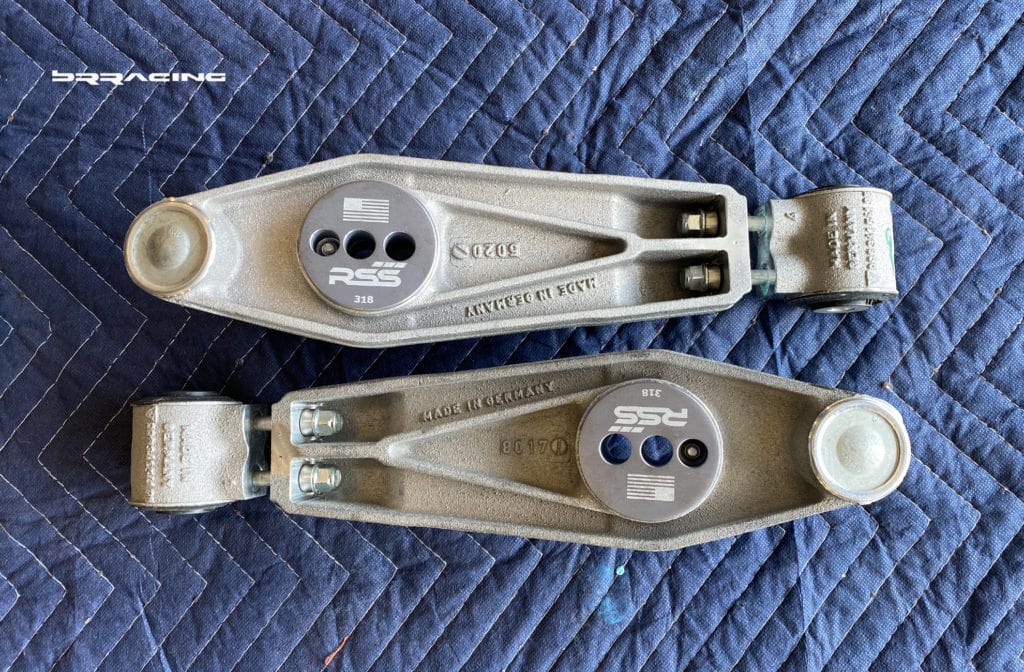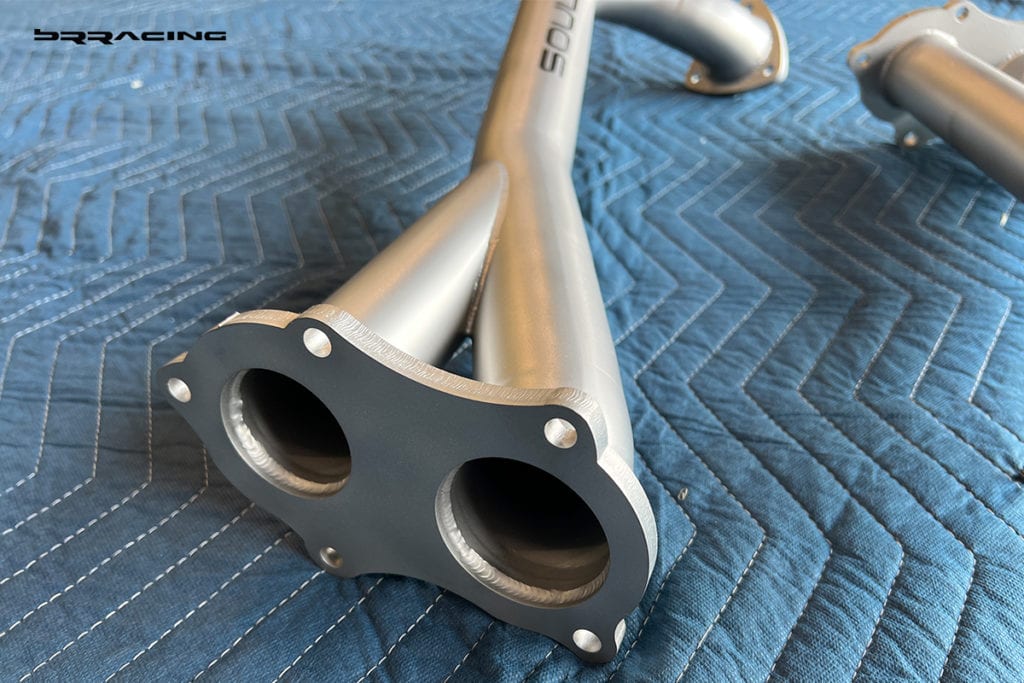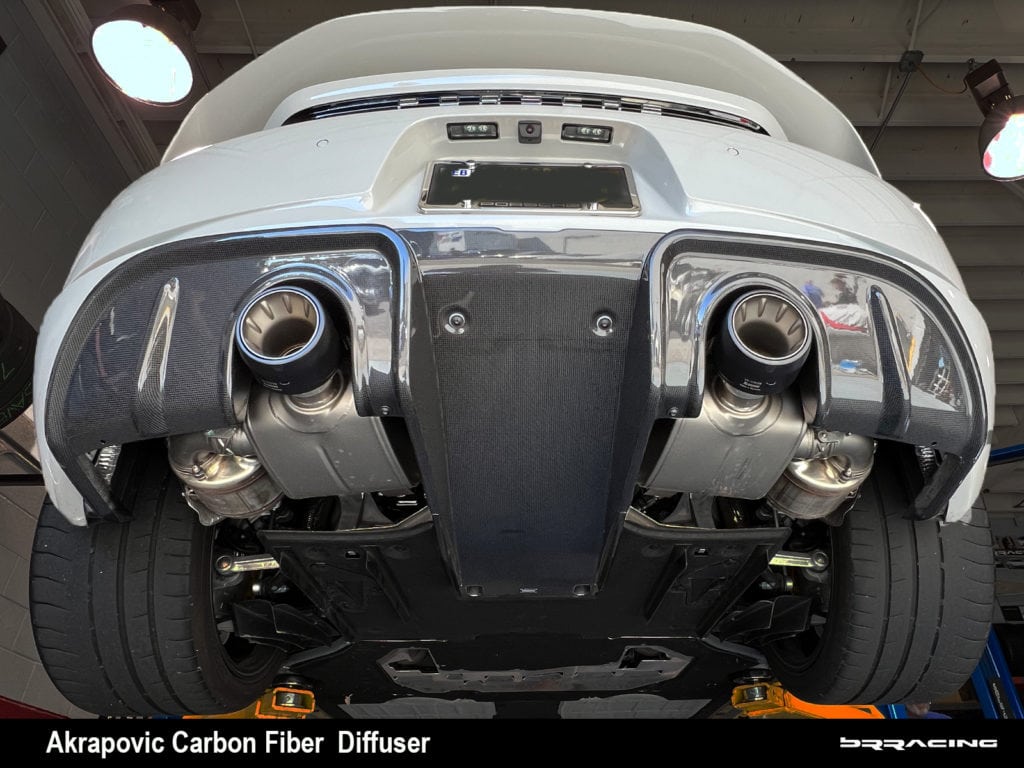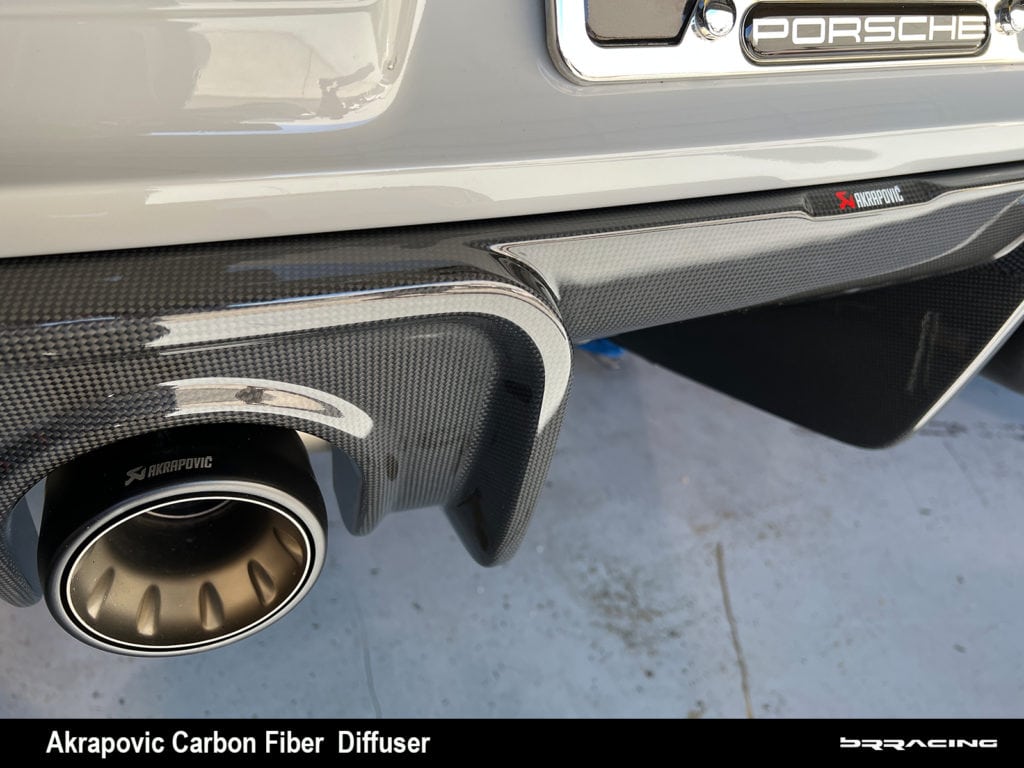Porsche 718 GT4 – Just Upgrade It
We are always surprised by the notion from so many customers, that the GT4 out of the box, is nearly a perfect car. This was certainly not the case w the prior generation 981 GT4, it was horrible out of the box. The newer 718 GT4 is much better, but still not the car it should be. We’re not talking about making the GT4 into a GT4RS, but just taking advantage of the platform to truly make it an outstanding dual personality car, both a daily driver and a great track weapon.
It doesn’t take a lot to alter the personality of the car the way it comes from the factory and to make it a wonderful car (the least amount it needs is a full custom alignment, the factory alignment is not set up to make the car work, it is set up to protect the driver from making a mistake that might cost Porsche a lot of money, so they dumb down the alignment to make it safe). We don’t want safe, we want fun. When you turn, the car should turn, when you get on the throttle hard, the rear should stick. But, if you really want to take advantage of the car and the platform, then there are quite a few things that can be done to transform the car. The more you do, the more the car responds….how much you do all depends on your use case, what tires you are running, and how hard you intend to drive the car. This is not a corner case….we have done more 718 GT4 upgrades than any other car in our history.
So, what needs, or can be upgraded? Just about anything. This is not a fully comprehensive list, but those things that we have found to have the biggest impact. Wheels, tires, exhaust / headers, alignment, suspension, interior / safety, brakes, body, data. The list that follows is not done in a phasing, as you can combine items to move from stock to modified.
ALIGNMENT
If you were to do nothing more than change the stock factory alignment, then you would have a much better car. The factory alignment leaves everything to be desired, the car doesn’t turn in well (understeers with the initial turn in), is OK in the middle of the turn, and then oversteers when applying hard throttle. If you are reading this, and have a 718 (even a 981 GT4 had this same feeling), and have not felt these traits, then it is likely that you are not driving your GT4 hard enough. The primary reason for this is not that the car is bad, but the alignment is. Not enough front negative camber, too much rear negative camber, wrong toe settings, and even the “rake” of the car is off slightly. The good news here is that the car has some of the GT3 underpinnings, and you can get to what we consider a baseline (Phase 0 setup) w the stock suspension. Based on the use case of the car, and the upgrades, we have 7 different alignment setups for the GT4. Many people seem to think that there is ONE perfect alignment or setup….not true, we tailor each setup to the customer and their car, to produce a “confidence” inspiring car….one that brings smiles for miles. If you were to want or need to get to the Phase 7 alignment, then you would likely need to upgrade the following: front Porsche Motorsport upper camber plates, front adjustable thrust arm bushings, and rear adjustable toe links (we will describe later in each section why you need these upgrades).
WHEELS
Even w the updated alignment, when you are pushing the car to the limit on the track, the GT4 will still have some traits that will frustrate the daylights out of you. The balance is not quite right. We have tried altering the setup by changing the rake, the sway bar settings, but you can’t get the car to do exactly what it should when you want it.
The primary issue here is the front tire size…it’s just too narrow. The car comes w 245 width front tires, but it needs 265 width. You can’t get there w the stock wheels, so the first big hurdle is new wheels. The best option here is a set of APEX wheels in the 19″ size (now, there are a bunch of requirements here….since the APEX wheels are size optimized to maximize the fitment, some things would need to change…you need a lot of front negative camber to provide clearance, which means you also need front adjustable thrust arm bushings, and you need rear adjustable toe links. One other caveat, the 19″ wheels will NOT clear PCCB brakes). You can get other custom wheels to accomplish the same result, however, they will either cost more money, or not be as optimized for the fitment as a set of APEX wheels are. As of the time of this writing, APEX offered three different designs in the fitment needed for the GT4 (APEX makes a 20″ set of wheels, that WILL clear the PCCB brakes, but these will NOT allow you to run the wider front tire)(APEX 19″ wheel options: Forged: VS-5RS, EC-7RS; Flow Forged: SM-10). There are also more track tires available in these sizes than the 20″ wheels.
The APEX VS-5RS is the wheel we have used most often, as seen on Charles’s GT4 above.
SUSPENSION
Depending on the use case, what should be upgraded in the suspension will change. But all options are on the table: (a) adjustable thrust arm bushings, (b) front upper camber plates, (c) rear adjustable toe links, (d) 2-piece GT3 style lower control arms, (e) springs, (f) shocks / coil-overs. We have not found that the sway bars need to be changed.
Rear Adjustable Toe Links
The stock toe link is just fine, it just doesn’t offer enough range of adjustment. When you push the rear negative camber above -1.7 (Phase 1 or higher), then you run out of toe adjustment. There are two types of rear toe links, a “pinch” bolt style, and a “jam” nut style. We would only go w the “pinch” bolt style. The version that we use is the Tarett (the unit also includes the bump steer element, but this is not a big deal, as we’re generally not changing the ride height, so, therefore, the geometry of the suspension has not changed). Porsche Motorsport also makes a good adjustable rear toe link (from the GT4 Clubsport), but just costs more. We have customers w both implementations.
Front Adjustable Thrust Arm Bushings
There are two reasons to upgrade the front thrust arm bushings (and why Porsche put solid units on the rear control arms, but rubber / non-adjustable units on the front is beyond us). First, under hard braking, the front thrust arm bushings deflect, causing “toe steer”, or instability (the car will feel like it is wondering side to side under thresshold braking). Second, as you increase the front negative camber, the caster gets too out of whack, and the front hub assembly will also be moved forward, causing interference (read rubbing) on the fender liner. Here is an example of the change before the adjustable thrust arm bushings are installed and the setting altered.
There are quite a few manufacturers / suppliers that make the adjustable thrust arm bushings. However, in our view, there are only two that work. Which you choose depends on your application, and long term plans. If your plans are only to go to alignment Phase 3, then the Elephant Racing set works well (the reason they work well, is they are the only set that offers a built in adjustment tool so you can alter the setting once installed). If you think you are going to go above Phase 3 alignment (anything above -2.4 negative front camber), then the best choice is the RSS set. The RSS works well too if you are only going to go to Phase 3 alignment, so below -2.4 you can choose either, but above -2.4, only the RSS will work (the Elephant does not offer as much range of adjustment as the RSS). Now, you could also just replace the thrust arm w a completely new, adjustable thrust arm, but that is not needed, will cost more, and will likely induce other issues. Stick w the stock thrust arm, and just replace the thrust arm bushing.
Control Arms
The good news is that the GT4 comes w the older GT3 style front 2-piece adjustable control arms (w rubber inner bushings). However, the car does not come w these installed on the rear. If you are intending for pure track use, and need rear camber to reach -2.3 or higher (we have some customers at -2.8 degrees of negative camber on the rear), then you will need the same 2-piece adjustable control arms on the rear (you do not need adjustable thrust arm bushings on the rear). It used to be easy (and less expensive) to get these arms, as Porsche used these arms on the 996 & 997 GT3’s, but now Porsche doesn’t make these arms any more, so you will likly need to choose from the aftermarket). These are 2-piece arms, and you can choose either the stock inner section w rubber bushings, or an aftermarket section w solid bushings (we would ONLY recommend the rubber for multiple reasons, as the solid ones just wear out too quickly, and can not take the abuse from track driving or worse, street driving). If you can find the stock outer arm (TRW made these, and may still), use it. If you need the aftermarket out section, we would recommend either the Tarett or RSS versions (both come w larger outer ball joints)
Front Camber Plates
There are two approaches to gaining the front negative camber the car needs. Depending on how aggressive w front negative camber you are trying to achieve, you can use either the camber plate or the 2-piece front lower control arm w adjustable thrust arm bushings to get above stock settings, but to get above -2.8 front negative camber you will need both the front camber plate and the 2-piece adjustable lower control arms w adjustable thrust arm bushings. You will need to use either if you are going to run the 19″ APEX wheels w the larger 265 width front tires. The front camber plate that we prefer is the Porsche GT4 Clubsport upper camber plate.
Spring, Shocks, Coil-Overs
All of the newer 718 GT4s come w PASM (Porsche Active Stabilty Management)….which means the car has active shocks. The shocks and other attributes of the suspension alter electronically. Now, on the 981 GT4, it was usually necessary if your were going to track the car to change the springs. On the 718 GT4, we find this will most likely be a personal preference. We have found that if you do all the other suspension upgrades mentioned previously, you may not need to change either the springs and / or the shocks. But, if you are going all in, then upgrading the springs and shocks is an option. There are two options once you decide you want to change….mechanical shocks, or other electronic shocks.
We have one customer, who is very dailed into his GT4, and the stock shocks (PASM) could not keep up w the car over bumps, so he decided to change out the PASM electronic shocks to a mechanical set w new spring rates (the option he choose was the MCS (Motion Control Suspension), 2-way adjustable w remote resv. We have worked w him and MCS to find the right combination of spring rates and canister pressures. There are many other “mechanical” coil-overs of the same definition (Ohlins, JRZ, Moton, AST, KW, Bilstein, Penske). We also have a couple of customers that wanted to stay w the electronic implementation, maintain use of the shock button on the center console. The most popular of these has been the Tractive solution. This also allows a selection of spring rates. (this is starting to get where the question needs to be asked, if we are investing this much into the car, should we just be getting a race car…but if you want the ultimate handling car, and have the requirement that it be able to be driven to / from the track, then this can make sense).
Now, if you are going all in w the Tractive system, you will also want to include the DSC control module. This now allows you to alter the shock settings just like you would on a mechanical system (and for a lot more scenarios than what a mechanical system will do). However, we have not found that you need the DSC module for the stock suspension. For most of the Porsche GT cars (GT3, GT4, GT3RS, GT4RS, GT2RS), we have not found the DSC to make a significant change, the shock valving is already near its limit, so that DSC doesn’t alter it much, unless you want softer settings.
BRAKES
We won’t dive into the steel vs PCCB arguement here (see our other blog articles on PCCBs). There are two scenarios here…if you have steel brakes (normally the red calipers), the the stock brake rotors just have to go. If you have PCCBs, and either need to change to steel (to fit in the 19″ APEX wheels), or want to keep the PCCB calipers (normally yellow), but want to preserve your PCCB rotors, you can swap out the PCCB rotors for steel. We have used / tested Brembo, PFC, AP Racing, but find the GiroDisc 2-piece brake rotors the best solution / value. The GiroDisc last longer, are less expensive….you can’t beat that.
ENGINE / HEADERS / EXHAUST
There are two considerations here. One is more performance oriented, the other is just pure sound and looks. One of the performance limitations in the GT4 engine is the exhaust headers / cats, so if you are looking to get any gain you can, the headers offer an option (however, if you are in California, and are worried about smog laws, then this is not an option). If you choose to do headers, the gain is not large, but it is a gain. Since we are in California, most of our customers focus on the other parts, the “over the axle” pipes (OAP), and the rear center muffler section.
When we talk to our customers about exhaust options, in our view, they all work well, it is more a personal question on what sound do you prefer? Each person has their own definition of a great sounding car. The systems that we have done the most of are: Akrapovic, SOUL Performance, and JCR.
Akrapovic
Over The Axle Pipes (OAP)
Akrapovic Rear Muffler and Tips
SOUL Performance
Over The Axle Pipes (OAP)
Over The Axle Pipes and Rear Muffler (they offer multiple options, not just what we have shown here)
INTERIOR / ROLL BAR / HARNESSES
Safety is always high on our list (in fact, if we know you are going to be using the car on the track, then this should be your first priority). Besides gaining safety (and ask us how we know these are safe, and work (yes, we have been in a students car when they have crashed and rolled the car, and harnesses, HANS, and roll bar saved our lives…..we will not get into a customers car to instruct unless we have all those), the harnesses and security in your seat save you seconds on the track. We have before and after cases, and when roll bars, seats, harnesses were installed, the customer dropped over 1.5 secs in their lap time…too much subconscious work is done to support yourself when these are not present).
Roll Bar
For our customers, we have promoted either the GMG Racing bar, or the Cantrell bar. There are several other roll bar options (BBi, Competition Motorsports), but we believe these are not as good. Choosing between the GMG and Cantrell bar mostly comes down to preference on peserving the interior. If you choose the GMG bar, then we need to implement the harnesses differently, as to get the shoulder harnesses at the right height / angle, we need to implement or mount them to the rear firewall (if you look at how Porsche has implemented their own bar (in the rest of the world, not the US), this is now they choose to install it). The Cantrell bar has the harness bar at the right height, but requires the horizontal bar to be cut thru the center console rear section. Depending on your height and seat choice, the Cantrell may limit how far back you can put your seat.
GMG
Cantrell Motorsports
Seats
If you either purchased your GT4 without the Porsche 918 Carbon Fiber seats, or purchased your GT4 used and they had the sport seats, then changing will be high on your upgrade list. There are lots of seat options (Recaro, Sparco, RaceTech, Tillet, and more). There are just a couple of considerations when picking seats. First, one piece or two piece (means it has a folding back). Full race bucket, or sports bucket? Whatever you choose, you need to be mindful of the “wings” of the seat, and fitting in the Porsche. Some seats have wider “wings” or the shoulder supports, and these will interfere w the upper door panel, preventing the door from closing.
Most seats will require the following: side mounts or base mount, sub-marine bar, and Porsche base to mount to the car. An example of one set up we have installed in a customers GT4 is the following: GMG Racing roll bar, Recaro Sportster ST seat, Cantrell Motorsports submarine bar, Recaro side mounts, and Planted seat mount base.
Harnesses
For Porsche, in our view, there is only one choice. Schroth 6-point, HANS compatible, Porsche specific harness set. The “Porsche” specific means the harness set comes w the proper type of mount for both the lap belts.
BODY
There are opportunities at every level to notch up the performance of the GT4. Taking a queue from the newer GT4RS, one option is in the aero area. If you pay close attention to the new GT4RS, the newer RS has quite a bit more downforce than the 718 GT4. This is much more than just the rear wing (and if you were to just add downforce by upgrading the rear wing, you would move the downforce balance in the wrong direction…the 718 GT4 is not wanting for rear grip, but it is for more front grip, therefore, if you added the rear wing (or rear wing only), the balance would be made worse, not better. So, what did Porsche do to the front to add more grip (downforce)….two things, a bigger front splitter, moved the front brake ducts, vents on the top and sides of the front fenders, changing the front radiator and side radiator inlets, and “rakes” on the underbody area.
We were surprised by the amount of downforce gain on the front end of the body by adding the new GT4RS “rakes”, or underbody guides just behind the front wheels. This was also seen on the 992 GT3 and 992 Cup cars.
Wing
Balance….balance, that’s what we have to remember when we start playing w downforce. Porsche had gone to great lengths to balance the downforce on the GT4 (and likewise, on the GT4RS). And bigger isn’t always better. But, we can take another trick from the racing world….we don’t need a bigger wing, but we can make it more efficient. If we make it more efficient, we can gain the downforce we need and actually reduce the “drag”….which is like FREE Horsepower. We could raise the wing (again, similar to what Porsche did w the new rear wing on the GT4RS, where it is both higher and more efficient).
There are a couple of wing “riser” kits on the market for the 718 GT4. Here is the a pic of the RSNV kit installed, and you can see the normal rear GT4 wing on the car in front of it:
There is a secondary benefit of raising the rear wing….you can see out the rear window.
Rear Diffuser
We have seen how almost all the current generation race cars focus on the rear diffuser for downforce….from F1, to Prototypes, to even aggressive implementations on a GT car in the likes of the Aston Martin GT3 race car. Porsche too has taken strides to move things around to allow a larger, more efficient rear diffuser.
So, while we’re not sure of the actual return or benefit, Akrapovic has come out w an aftermarket rear diffuser in Carbon Fiber. Light weight, strong, and very pretty.
Front Window Deflectors
While not a performance change, one of the vital upgrades on either a GT4 or GT3 is the front window deflectors. When driving over 50 mph, the amount of disturbance in the interior cabin with the windows down is almost unbearable. There are now lots of options out there, starting at less than $100 for a set.
There is always more that you can do…
We often define cars as being in one of three states: Street cars that can be driven on the track, Track cars that can be driven on the street, and race cars. When you start upgrading a street car for track use, you need to keep this premise in mind. At some point, there is both a financial thresshold, and a performance thresshold, and if the ultimate track car is the objective, then just buy a used race car.
But, so far, for all our GT4 customers, we have kept it below that thresshold, and these were the upgrades that made the most sense.
If you have a GT4, you are very lucky…one of the best overall sports cars, and track cars there is. But, if you want help in knowing what to do to make it even better, talk to us.
BRracing – producing amazing cars

